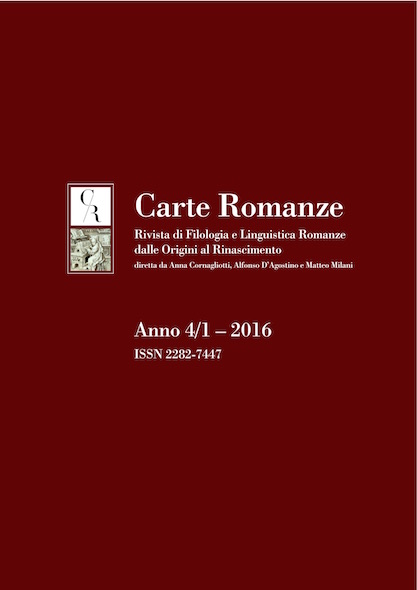Abrahán Judío. Segunda “novella” del «Decameron» castellano
Main Article Content
Abstract
El ensayo analiza el segundo cuento del Decameron en su traducción española del siglo XV, fijando el texto de forma provisional y tratando de describir el modus operandi del traductor. Para establecer un texto viable se usan el único manuscrito conservado, el escurialense J-II-21, y el impreso toledano de 1524, derivado de la editio princeps de Sevilla 1496, que se remontan a un mismo arquetipo. Se comparan las variantes de los dos testimonios con la edición de la obra de Boccaccio, teniendo en cuenta especialmente el ms. parisino, el cual, con otros códices, representa una “forma” anterior a la definitiva, y que fue la que tuvo el éxito más inmediato, traduciéndose también al francés y al catalán. En el análisis literario se propone un esquema de diez tipos de intervenciones, voluntarias e involuntarias, del anónimo castellano.
The essay analizes the second tale of the Decameron in its Spanish translation from the XV century, fixing the text in a temporary way and trying to describe the translators’ modus operandi. In order to establish a viable text the only conserved manuscript is used, the escurialense J-II-21, and the impreso toledano from 1524, derived from the editio princeps of Sevilla in 1496, which all date back to the same archetype. The variants of the two texts are compared to the edition of Boccaccio’s work, taking into account especially the Paris manuscript, which, together with other codices, represents a “form” previous to the definitive one, and was the one with the most immediate success, being translated in French and Catalan as well. In the literary analysis a scheme of ten types of interventions by the Castilian anonymous, voluntary and involuntary, is proposed.
Article Details
Carte Romanze si serve di una licenza  Creative Commons. Attraverso la licenza CC-BY-NC-ND gli autori conservano tutti i diritti economici e concedono alla rivista il diritto non esclusivo di pubblicazione, permettendo a chiunque di scaricare il contributo, di leggerlo e stamparlo. Ogni riuso deve prevedere la citazione virgolettata (o comunque riconoscibile), garantendo all’autore la proprietà intellettuale di quanto citato, e segnalando sempre e comunque la rivista come fonte (con l’indicazione dell’annata, del volume e delle pagine). Non è invece concessa a nessuno la modifica del contributo né il riuso per creare opere secondarie.
Creative Commons. Attraverso la licenza CC-BY-NC-ND gli autori conservano tutti i diritti economici e concedono alla rivista il diritto non esclusivo di pubblicazione, permettendo a chiunque di scaricare il contributo, di leggerlo e stamparlo. Ogni riuso deve prevedere la citazione virgolettata (o comunque riconoscibile), garantendo all’autore la proprietà intellettuale di quanto citato, e segnalando sempre e comunque la rivista come fonte (con l’indicazione dell’annata, del volume e delle pagine). Non è invece concessa a nessuno la modifica del contributo né il riuso per creare opere secondarie.
Quando siano rispettate le indicazioni di cui sopra, non è necessario richiedere ulteriori permessi di utilizzazione del materiale né all’autore né al comitato scientifico.

